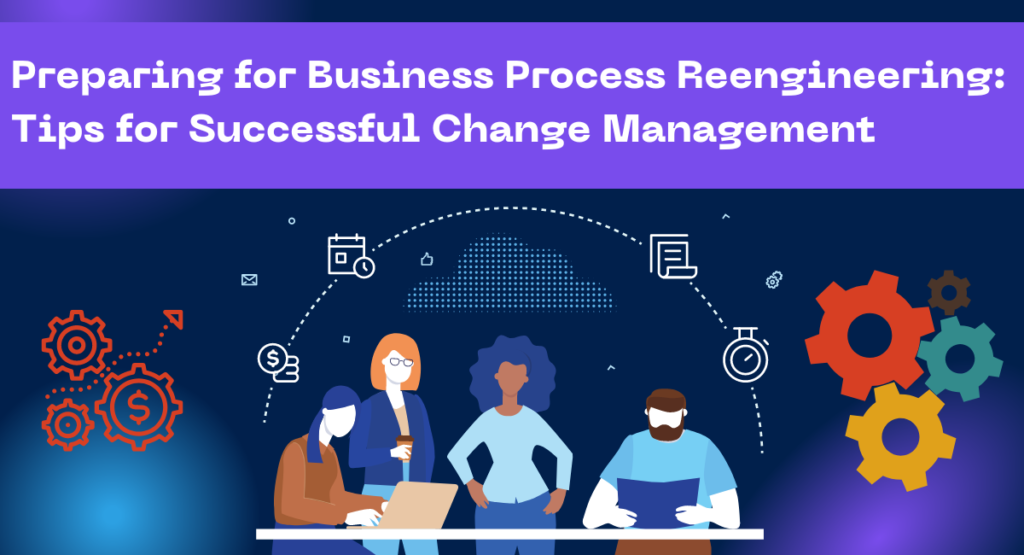Preparing for Business Process Reengineering: Tips for Successful Change Management


You’ve likely heard the buzzword “business process reengineering,” but do you know what they mean?
More importantly, do you know how BPR can impact your business? If you need more time, get ready to learn how this strategy can completely transform your operations.
Business process reengineering, or BPR, is revamping existing business processes to achieve greater efficiency and increased productivity.
The implementation is through various means, such as automation, streamlining tasks, and restructuring structures.
The goal is to efficiently use resources by eliminating waste and inefficiencies.
This article will explain how business process reengineering can help revolutionize your business. We’ll review the benefits, best practices, and challenges associated with BPR and comprehensively explain the implementation process.
Keep reading!
What is Business Process Reengineering (BPR)?
Business Process Reengineering was introduced in the early 1990s to transform businesses’ operations radically.
The idea behind BPR is that organizations should evaluate their current business processes. Companies redesign processes from the ground up to increase efficiency and productivity.
BPR has become one of the most popular business tools used by executives and managers looking to drive change within their organizations.
Why is BPR important, and why should businesses consider it?

“Efficiency is not sufficient—that you need to be focused on ways to create more and more value, not just cut costs.” John Hagel.
Business Process Reengineering (BPR) is an innovative technique for improving the operations of any organization.
BPR attempts to make fundamental changes in how a business operates, from its processes and procedures to its organizational structure and culture. It’s a must-have tool for any executive or manager looking to drive business transformation.
Let’s examine what makes BPR so effective and explore its key benefits.
The Goals of BPR
Business process reengineering involves analyzing existing business processes to identify the section where they can be improved or streamlined.
The analysis helps ensure that every step in the process is as efficient as possible, allowing for faster turnaround times and improved customer satisfaction.
Benefits of Business Process Reengineering

The main benefit of business process reengineering is that it allows businesses to quickly identify areas where companies can make improvements without overhauling their operations completely. The BPR can save time and money while helping companies to stay competitive in an ever-changing marketplace.
Steps to Implement Business Process Reengineering
Business Process Reengineering (BPR) is an important tool that helps executives and managers streamline their business processes.
BPR can help reduce costs, increase efficiency, and improve customer satisfaction by analyzing, designing, and implementing changes to current processes.
Let’s explore the steps involved in successful Business Process Reengineering.
- Analyzing Current Company Processes
The first step in BPR is analyzing current processes. The analysis involves studying existing business processes and documenting how they function. It is essential to understand who is responsible for each procedure and how it fits into the workflow.
Analyzing current processes also involves exploring where there are opportunities for improvement. Identifying areas of inefficiency or redundancy can help you develop more efficient strategies that save time and money.
- Designing New Core Business Processes
Once you have a clear business flow of your existing processes, you can begin designing new ones that are more efficient and cost-effective.
The new process includes the following:
- Mapping out the flow of business operations from start to finish.
- Identifying potential bottlenecks or redundancies.
- Ensuring all stakeholders are on board with the new process design.
Be sure to consider the potential impacts of any changes:
- Both positive and negative
- On your employees, customers, vendors, Etc.
As this will help ensure a smoother transition toward implementation.
- Implementing Changes
The final step in BPR is implementing changes to your business processes. The implementation includes:
- Training employees on the new process designs.
- Updating any critical systems or technology required to support them.
- Monitoring progress throughout the transition.
It is also important to measure performance over time to identify areas for further improvement or refinement. Additionally, communicating regularly with all stakeholders throughout the process will help ensure a successful transition into the new system(s).
By following these steps carefully, organizations can ensure success when making organizational improvements through BPR.
Tips for successful BPR implementation

Business Process Reengineering is seen as a rather daunting task to many, with its clear potential to revolutionize entire business operations.
However, the successful implementation of Business Process Reengineering can benefit those willing to take on the challenge.
It requires strong leadership, with those leading the initiative guiding their team through a thoughtful process that starts and ends with understanding the current environment and considering everyone the changes will impact.
When implementing Business Process Reengineering for the first time, start with a small portion of your processes, as this allows for problems to be quickly identified and corrected.
Encourage active collaboration across all departments within your company and have frequently scheduled meetings to review progress and assess the viability of changes.
Finally, remember that Business Process Reengineering involves making difficult decisions, so ensure that you have a few good people steering the initiative who are confident when they make such decisions.
With such advice, Business Process Reengineering implementation can move swiftly with the right support.
Effective Business Process Reengineering involves:
- Creating new processes.
- Digitalizing them where necessary.
- Staying aware of top trends in management and forecasting.
Business Process Reengineering will set a company up for success when executed thoughtfully.
Examples of Successful Business Process Reengineering

Check out these head-spinning global corporations that went through some crazy Business Process Reengineering (BPR) transformations with some pretty wild results:
Procter & Gamble (P&G)
In the 90s, P&G went on a wild BPR adventure to lower costs and increase efficiency. They hacked away at their supply chain by designing new, jazzed-up processes, cutting down inventory levels, and being bosom buddies with suppliers.
The result? P&G shaved a cool $1.2 billion off its costs and significantly boosted customer service levels.
Honeywell
Honeywell was like, “Let’s do this!” when they implemented their BPR program in the 90s, targeting the reduction of cycle times, boosting quality, and delivering satisfaction to the people. To get there, they made some crazy changes to their processes by scrapping any nonsense steps, increasing communication and collaboration, and slashing lead times.
The result? Honeywell’s cycle times fell by a crazy 50%, quality improved, and customer satisfaction skyrocketed.
Siemens
Siemens was like, “Let’s whip it into shape!” when they implemented their BPR program in the early 2000s to improve their product development. They remixed their processes to create better harmony between different departments, lower the number of design changes, and better use digital technology.
The result? Siemens reduced time-to-market, improved quality, and increased revenue.
General Electric (GE)
GE was like, “Let’s rock and roll!” in the 90s when they decided to improve their manufacturing processes through BPR. They implemented some heavy-duty process changes by trimming cycle times, cutting out waste, and pumping up quality.
The result? GE’s manufacturing cycle times plummeted by 75%, quality skyrocketed, and productivity went through the roof.
IBM
In the 90s, IBM was like, “Let’s do this, baby!” and implemented a BPR program to improve customer service and lower costs. They mixed things up by cutting out any dead weight, boosting communication, and using technology to streamline and automate their processes.
The result? IBM knocked off a cool $1 billion in costs and brought their customer service levels to the next level.
These corporations, as well as the previous examples I provided, prove that the rewards of BPR can be out of this world when done right.
The impact of BPR on company culture and employee engagement

Business Process Reengineering (BPR) has become an increasingly important tool for modern organizations.
BPR profoundly impacts how companies structure themselves internally, leading to increased efficiency in the workplace. This restructuring affects processes, company culture, and employee engagement.
By fostering a more streamlined approach to work, BPR can help employees channel their energy into their job in meaningful ways. It sparks new ideas and innovation and leads to greater job satisfaction, positively impacting morale and fueling further growth.
By incorporating Business Process Improvement (BPI), organizations can work closely with their employees to develop an overall culture of innovation, agility, and value creation.
As a result, not only are companies better able to meet customers’ needs, but employee satisfaction is higher as morale is kept positive through shared accountability and mutual goals.
With BPR guiding the way, individuals feel valued and appreciated because they are truly part of a growing team working together towards worthy change.
Challenges of Business Process Reengineering
Business Process Reengineering (BPR) is a process for improving organizational performance. While BPR offers many potential benefits, there are some challenges that companies must address to ensure successful implementation.
From resistance to change and lack of resources to inadequate training and unrealistic expectations, several common challenges can prevent organizations from realizing the full potential of BPR.
Resistance to Change
One of the most common challenges in BPR implementation is resistance to change.
People may be hesitant or unwilling to accept changes to their routines, even if they could improve the organization’s overall performance.
Organizations need to communicate clearly and openly about why the changes are being made and why they believe they will benefit the organization in the long run.
It’s also essential for organizations to solicit feedback from employees and make sure their concerns are heard and addressed.
Lack of Resources
Another common challenge with BPR implementation is a lack of resources—both financial and human. Many organizations may not have enough money or personnel to implement BPR initiatives effectively.
Organizations should work with existing staff members whenever possible to overcome this challenge and focus on making small but meaningful improvements rather than large-scale overhauls. Additionally, organizations should consider outsourcing specific tasks, such as research or data analysis, when necessary.
Inadequate Training
In addition to a lack of resources, inadequate training can be a major obstacle to effective BPR implementation. With proper training, employees may understand how best to transition into new processes or systems, which can lead to clarity among team members.
Organizations should ensure that all employees receive adequate training on new systems or processes before they are expected to use them daily.
Additionally, organizations should identify key stakeholders who can act as mentors or support during the transition period to help smooth out any bumps.
Frequent Ask Questions
How does business process reengineering differ from process improvement?

Process improvement involves incremental changes to existing processes to improve efficiency. On the other hand, business process reengineering involves completely rethinking processes from the ground up to create a more streamlined and effective system.
How long does business process reengineering take?
The timeline for business process reengineering can vary depending on the company’s complexity. Some projects may take a few months, while others can take a year or more. It’s essential to take the time necessary to thoroughly analyze and redesign processes to ensure the best possible outcome.
Can business process reengineering work for any company?
BPR can be effective for any company as long as there is a commitment to change and a willingness to undergo the necessary analysis and redesign of processes. However, it may not be appropriate for small companies or those with very simple processes.
Conclusion
Business Process Reengineering (BPR) is a technique for improving the operations of any organization by making fundamental changes in how it operates.
The goals of BPR include reducing costs, increasing efficiency, and improving customer satisfaction.
Implementing BPR involves analyzing current processes; designing new core business processes; implementing changes; and measuring performance over time. Tips for successful implementation include starting with the following:
- A small portion of your process
- Encouraging active collaboration across all departments within your company
- Having frequently scheduled meetings to review progress
- Assess the viability of changes
Remembering that difficult decisions will need to be made during the process and staying aware of top trends in management and forecasting.
Challenges can arise, such as resistance to change or lack of resources; however, proper communication and adequate training can be addressed before transitioning into new systems.


